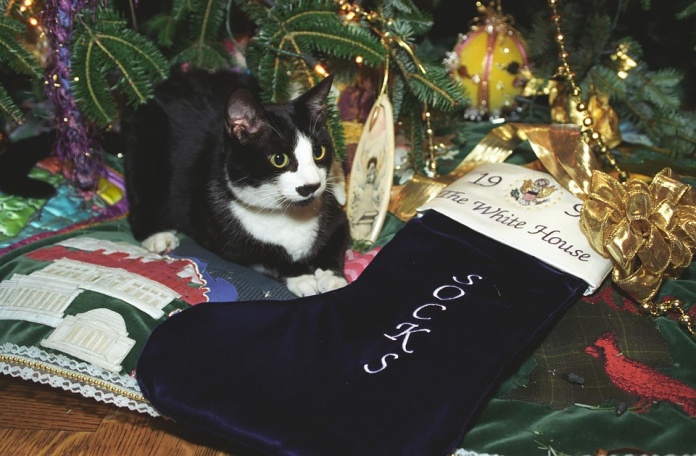Many of us have an ideal picture in our heads of the perfect glowing Christmas tree in front of the hearth with flowers and candles throughout the room and the adorable Labrador puppy sitting in front of the tree, ribbon in his mouth and his present between his paws. Look closer at the picture to reveal the dangers our pets face at Christmas.
At Christmas, veterinarians see a huge increase in dogs suffering from what we call “Garbage Gut Gastritis”. Gastro-intestinal upsets ranging from mild to potentially life-threatening and can ruin Christmas… so practice restraint. Cooked turkey bones splinter and ham is far too rich for most pets to tolerate. Bowls of treats left out on coffee tables beg to be eaten…Yum! And if the goodies can be sniffed out in wrapped box under the tree at floor level, even a well-behaved pet may believe “it’s mine”. Remember chocolate, especially dark chocolate, is toxic to dogs and can cause heart problems.
Mistletoe, holly, lilies, and poinsettias are all toxic to varying degrees to pets and children. This Christmas we have a new threat, those THC laced cannabis products may also be given as gifts. Dogs and cats seem to be attracted to cannabis leaves. THC is toxic to dogs or cats in any amount, protect your pet.
Ribbon, twine, and tinsel fall under the veterinary category of “linear or string foreign object” if ingested. They are doubly dangerous because the sharp edges of ribbon and tinsel can cut the lining of the gut. The free ends move down the intestine and act like knives as the normal waves of motion pass through the guts. Diagnosis of the problem can be difficult because there is no complete blockage and the ribbon does not show up on radiographs or x-rays. Decorations with wires in the middle and popcorn or candy on the outside go down the gullet easily, but don’t pass through so well. What veterinarians have seen animals eat or swallow whole over the years is usually limited only by your imagination! Some veterinary journals have competitions inviting vets to share our most impressive radiographs of the things our patients eat!
Flickering candles, tree ornaments and all the electrical wires necessary to light our homes are as attractive to a pet as they are to a young child. All those bright ornaments can shatter and lacerate your pet’s paws or mouth. Pawing at the flickering light of a candle or chewing a wire may cause a fire in your home. If you have a pet… stand back and look at your house with the same mindset to as if you were protecting an infant or young toddler from their dangerous curiosity.
With the additional socializing inherent to the holiday season, make sure your pet is wearing identification in the event they slip out the door. If parties are not to your pet’s taste, confinement in a quiet isolated part of the house is preferable. Between the lights and the excitement, I find many of my epileptic patients have more seizures and many of my fragile elderly patients are more likely to become stressed and ill.
Finally, making a pet a part of your family should never be an impulse purchase. Nor should pets be given as gifts. This is why many humane societies halt adoptions at Christmas time. Make sure you take a little time to think through if you have the space, time, and financial resources to support a pet.
Christmas morning many furry children have their own gifts under the tree (mine do). Select a pet’s gifts with the same attention to safety you would give a gift selected for a toddler. Have very Merry (healthy and safe) Christmas!









